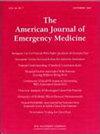Disparities in troponin and ECG testing among emergency department patients with chest pain
IF 2.7
3区 医学
Q1 EMERGENCY MEDICINE
引用次数: 0
Abstract
Background
Prior studies have highlighted disparities in the evaluation of chest pain based on patient race and sex. However, these studies were limited by small sample sizes and may not represent national practice patterns. This study evaluated differences in electrocardiogram (ECG) and troponin testing among emergency department (ED) patients presenting with chest pain or anginal-equivalent symptoms, focusing on variations by sex, race, ethnicity, and primary spoken language.
Methods
A retrospective cohort study of patients presenting with chest pain or anginal-equivalent symptoms from 01/01/2016–12/31/2023 was conducted by searching the Epic Cosmos research platform separately for ECG and troponin testing. ECG and troponin testing rates were stratified and analyzed by age, sex, race, ethnicity, and primary language. Conditional logistic regression was used to calculate odds ratios (OR) with 95 % confidence intervals (CI).
Results
Among 205,526,173 adult ED visits, 37,138,334 (18.1 %) met the inclusion criteria for chest pain or anginal-equivalent symptoms. For patients with full demographic data available, 30,648,879 of 36,672,008 (83.6 %) and 26,615,155 of 36,672,075 (72.6 %) underwent ECG and troponin testing, respectively. ECG testing was more frequent in male patients (OR:1.059; 95 %CI:1.058–1.060), Asian patients (OR:1.006; 95 %CI:1.004–1.009), and patients primarily speaking Spanish (OR:1.039; 95 %CI:1.040–1.042) or other non-English languages (OR:1.054; 95 %CI:1.051–1.056). However, it was less frequent among Black or African American patients (OR:0.955; 95 %CI:0.954–0.956) and individuals identifying as other races (OR:0.961; 95 %CI:0.959–0.963). Troponin testing was also more common in male patients (OR:1.087; 95 %CI:1.086–1.087) and those primarily speaking Spanish (OR:1.016; 95 %CI:1.014–1.019) or other non-English languages (OR:1.064; 95 %CI:1.061–1.067), but less common among Hispanic or Latino patients (OR:0.923; 95 %CI:0.921–0.924) and non-white patients (OR range:0.918–0.950).
Conclusions
Disparities in ECG and troponin testing were identified among ED patients presenting with chest pain or anginal-equivalent symptoms. Testing rates were lower in female and non-white patients, while patients primarily speaking non-English languages had higher testing rates.
求助全文
约1分钟内获得全文
求助全文
来源期刊
CiteScore
6.00
自引率
5.60%
发文量
730
审稿时长
42 days
期刊介绍:
A distinctive blend of practicality and scholarliness makes the American Journal of Emergency Medicine a key source for information on emergency medical care. Covering all activities concerned with emergency medicine, it is the journal to turn to for information to help increase the ability to understand, recognize and treat emergency conditions. Issues contain clinical articles, case reports, review articles, editorials, international notes, book reviews and more.

 求助内容:
求助内容: 应助结果提醒方式:
应助结果提醒方式:


